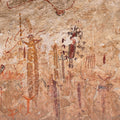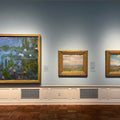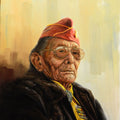The Abeyta you know, and those you don't, on view together at Wheelwright Museum
By Medicine Man Gallery on

Tony Abeyta, 2021. Photo by Larry Price
Anyone even a little bit interested in Western art or Native American art should be familiar with the name Tony Abeyta. No museum or important private collection of the material can be considered complete without him.
The names Narciso Abeyta (1918–1998), Pablita Abeyta (1953–2017) and Elizabeth Abeyta (1955–2006) are less familiar among aficionados, if not totally unknown. The four family members – father, daughters and son – come together at the Wheelwright Museum of the American Indian in Santa Fe for the exhibition “Abeyta | To’Hajiilee K’é,” on view through January 7, 2023.
The title references the Navajo word K’é, meaning family and connections to love and compassion. The Abeyta family is originally from Cañoncito, New Mexico, currently known as To’Hajiilee, and is specific to the Cañoncito Band of Navajo, located West of Albuquerque.
Becoming Tony Abeyta
While Tony (b. 1965) – the baby of the family – has fame eclipsing his sisters and dad, he readily acknowledges standing on their shoulders to achieve his level of success.
“I was really raised by sisters,” Abeyta said of his much older siblings. “My dad was always at work, but my sisters were always at home, so I've always had these really amazing, powerful women that were part of my, upbringing. They kept me in line, they directed me, and always – not only inspired me – but supported all my artistic endeavors.”
That support, in a very basic, tangible way, is the reason the art world knows the name Tony Abeyta.
“Elizabeth was very much responsible for getting me to leave my job – I was a protectionist in a movie theater in my hometown in Gallup, New Mexico,” Abeyta remembers. “I was trying to escape, one of those situations where I was like, ‘I gotta’ get out of this town. I gotta’ leave this podunk place,’ and she said, ‘Why don't you apply to the Institute of American Indian Arts?”
Tony Abeyta had a good reason for not doing so.
“I'm not a good enough artist,” was Tony’s response to Elizabeth. “She goes, ‘Well, you will be. I’ll make some phone calls.”
Which she did.
“I submitted my application, and I think because she was so beloved with that Institute, they got me in,” Abeyta said, having a hard time believing it could have been his talent which provided for admission. “I barely could draw anything. I was going through a portfolio (recently) of some of the work that I did to apply to the school and it was (he laughs) – it was cute. Work of a novice.”
But thanks to the recommendation of Elizabeth, Tony quit his job of eight years at the historic El Morro Theatre on Main Street in Gallup and went off to Santa Fe and IAIA and eventual fame and fortune.
Fame and fortune would be kickstarted by Pablita.
By the time Tony was in school, Pablita had worked her way up to becoming an important figure in American Indian politics. She had worked in the Navajo Nation. She had worked for numerous politicians including Colorado Senator Ben Nighthorse Campbell. While Tony was at IAIA, Pablita was lobbying Congress for funding of a new National Museum of the American Indian to be constructed on the National Mall in Washington, D.C. – an effort to which her contribution was essential.
“She knew people so she would say, ‘This is my little brother Tony's work that he's doing in school,’ and so they would buy a few things from me,” Abeyta remembers of Pablita’s support. He put the money to use buying canvases and gesso.
Later, when he attended the Maryland Institute College of Art in Baltimore, with his sister in nearby D.C., he would use her house as a base from which to explore the wider world of art.
“I would stay at her house and go to the museums; we'd go to the National Gallery and the Hirshhorn and Renwick and I started looking at contemporary art,” Abeyta said. “I was digesting the whole pantheon of really great world artists. I could look at Italian art one day and then I would be looking at New York Abstract Expressionism, Cubism, and I’d bring a painting with me and she’d call a friend and I’d go back to school and have money to go get sushi with my friends.”
His sisters’ support always extended beyond calling in favors.
“Someone who just tells you you're good and that you're going to be great really helps because I did come from this alternate place in a small town where the possibilities of being an artist, a self-sufficient self-supporting artist, was unheard of,” Abeyta said.
Elizabeth Abeyta, 1955–2006 (Navajo), Untitled (Trickster), 1984. Clay, paint, leather, turquoise, silver, shell, beads. Private Collection. Photography by Addison Doty
The Abeyta Family Exhibition
Narciso, Pablita and Elizabeth all died from complications related to alcoholism. Tony has been clean and sober for about 16 years. His sobriety honors their legacy, as does the work of theirs he has collected.
“I have a lot of their artwork, a few pieces in the exhibition are from my personal collection,” Abeyta said. “Their way of working was still very much a part of my own, so I think this exhibition is a really important reminder of where I came from, how it all happened in different chapters, and the way I work, the way my father works and who influenced us, how we influenced each other.”
He has also contributed works of his own for “Abeyta | To’Hajiilee K’é.”
“I chose about 15 works to include in this exhibition, mainly (selected) because I wanted to keep that focus on whatever I have been working on that felt for me personally was part of the language that directly came from the dialogue and the experiences of my family,” Abeyta said. “The sensitivity, the balancing between masculine and feminine and all of these ideas about the universe that we live in, that we have this connection with other living organisms – botanical, microscopic – and all of those things live concurrently with us.”
Visitors expecting the landscapes and deity paintings which have come to define Abeyta’s career will be in for a surprise. What he’s selected to exhibit here are all black and white, monochromatic. They're abstract. Most of the works are large scale drawings.
“Memories, eras… the spirit world is still relevant and in my consciousness, it still exists in my current life and day, so for me, the drawings we're addressing these ideas,” Abeyta explains. “We’re talking so much about the metaverse and parallel universes, and really, within the Native American ideology, there is the spirit world and the ancestral world where the people that came before still live with us and still live within us; we are part of them and we're part of that discourse. For me, I'm looking at that artwork which is still very much a part of my father's legacy, my sister’s, my mother's – I haven't talked about my mother, she was supportive of all of us. None of us could have done what we did without her.”
Who’s Next?
Will a third generation of Abetya’s carry on the family artmaking tradition? It seems likely. Tony’s son is a musician and aspiring filmmaker living in Barcelona. His daughter is in design school in Amsterdam. Dad has now assumed the support role his family played for him.
“I've always raised them (saying) you don't have to be rich, you don't have to be famous, but you should be passionate about what you do. Love what you do and you'll always be happy,” Abeyta said, including this more sobering reminder, “And struggle; struggle is OK. I tell people sometimes that it's okay to struggle through all of this. There are no gains without (struggle). (The idea) this was supposed to be easy – to survive off your own creativity – that is a romantic narrative.”
Tony Abeyta (b. 1965) - Creations Portal / Night Songs | Sandpainting | Circa: 2000-2001 | 48'' x 96''





